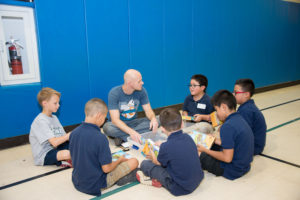
1. Establish a safe environment.
Early in the year, make sure that you talk with your group about what you expect small group discussion time to look like, and clarify the boundaries. Set ground rules regarding respecting one another’s turn to talk, listening to others, and being accepting of what others have to share. In order for students to really open up and engage during discussion time, they need to know that they will not be disrespected or made fun of by their peers, or have their answers dismissed by their leader.
2. Make it FUN!
Keep kids more engaged by turning small group discussion time into a game! Kids love friendly competition. Playing in teams always works best so that individuals don’t have to be singled out for answers if they don’t want to be. Also, since discussion questions often don’t have a “right” answer, the competition isn’t based on the content of the responses, so the students will be more eager to share without fear of making a mistake and letting their team down. Here are a couple of favorite games:
-
- ZAP! – Zap! is a game of chance in which a team member who answers a question pulls a numbered card from an envelope. The player keeps the points on the card, and gets to choose whether to keep the points or pull again and add whatever is on the next card to their first number. They can continue to pull as many times as they want, but if they pull a Zap! Card, they lose all the points from that round.
- Memory – Using a pack of memory/matching cards, lay all the cards face down. When a team member answers a question, they can choose two cards to see if they make a match. If it’s not a match, the next team gets a turn to answer a question and look for a match. If it is a match, they keep the cards and get a free chance to look for another match.
- Dice Dash – After answering a question for their team, a player chooses a number and rolls five dice. Say, for example, they chose a 6. If they roll a 6 as one of the dice, they can continue to roll or stop and record the sum of all their dice. If they do not roll a 6, their turn is over and they lose all the points from that turn. They must decide whether to keep their points or roll again before each roll. Keep score – the team with the most points at the end wins!
 3. Encourage deeper thinking.
3. Encourage deeper thinking.
When a student answers a question, ask another question to follow it up. Challenge them to think more deeply by tagging on something like “What do you mean by that” or “Why do you think so?” When a student poses a question, first allow the group a chance to respond to the question. For example, when studying the Parable of the Sower, a student asked, “Why are there so many bad soils and only one good soil?”
To encourage critical thinking, I allowed the group to respond before I did by asking, “What do you guys think?” As the discussion leader, your goal is not just to provide a quick biblical answer, but to guide students to engage with the content of Scripture personally. You want to provide clarity and guidance when it’s necessary, but don’t miss opportunities to push students to think more deeply for themselves about spiritual matters. Then, point them to God’s Word for answers. Creating this kind of environment in which students are challenged to think critically will help them to develop a curiosity and a hunger for more of God’s Word.














































